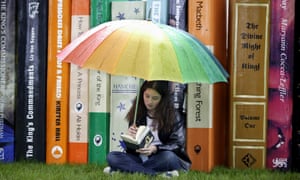The elements of a great story have no gender – so why do we market books to young readers as if girls and boys want different things from fiction?

What makes readers pick up young adult fiction? The promise of a strong story, characters with emotional depth and intelligent writing. And yet a shelf of YA books might still suggest a world in which boys and girls make their reading choices based upon their gender.
Almost from birth, readers are coralled into the pink and blue worlds of sparkle for girls and adventure for boys. But, as American YA author Libba Bray points out, books have no gender – titles for young adults, she argues, should have gender neutral covers. “We have to move the needle,” she says. “If you categorise books as for boys or for girls, the message is that boys don’t need to be concerned about the female experience. And vice versa.”
Bray was speaking last weekend as part of a lively panel on YA fiction and gender at the biennial Reading Matters conference at the State Library of Victoria, which I attended as one of 16 YA authors.
I’ve written five YA books – the epic fantasy quartet The Books of Pellinor, which has sold half a million copies worldwide, and Black Springwhich is published in the US in August. When I was still an science fiction and fantasy newbie, I was surprised when I stumbled across readers in forums opining largely that fantasy by women was just fluffy romance, unlike the grittier, more “realistic” male authors. Aside from wondering why fantasy has to be “realistic” – surely a contradiction in terms – I’m sadly no longer surprised. Sexism is a hot topic in both fantasy and YA.
I can’t complain about the design of my Pellinor books. The UK/ Australian editions especially are excellent examples of neutral design, presenting them as straight epic adventure. But Black Spring, a feminist Gothic fantasy set in a misogynistic, vendetta-centred society, is undeniably aimed at girls: however beautiful the covers are, they have definite leanings towards pinkness. After the discussion on gendered covers, I found myself wondering if there are boys who might enjoy the story, but will be put off by the cover. I didn’t, after all, write it only for girls. I wrote it for readers.
Gendered book marketing has particular impact upon boys. Girls, as Brooklyn-based author Gayle Forman explained at Reading Matters, will read across gender. But boys are often self-conscious about reading books that might be considered to be “girly”. “Why is it acceptable for a girl to enter a boy world, but not the opposite?” Forman asked.
The reason is, of course, that books exist in a society where femininity is still considered to be a second-class characteristic, and masculinity defined most strongly as an absence of the feminine. The debate about “fake geek girls” in fan culture, the current meltdown at the SFWA about sexism in science fiction and fantasy, even the furore over Faber’s chicklit reprint of Sylvia Plath’s novel The Bell Jar, demonstrate that misogyny and sexism are alive and well.
As YA author Maureen Johnson demonstrated in Coverflip, an eye-opening experiment in which popular book covers are given regendered makeovers, books by women are routinely given “feminine” motifs, while books by men are designed to neutrally reflect the story. She used one of her own books, The Key to the Golden Firebird, as an example. A story of a family struggling with bereavement, its cover portrays a pretty young woman on a bright pink background. The tagline “A novel” is enclosed in a pink heart. “Now, as a mental exercise, imagine I’m Maurice Johnson,” says Johnson. “The book has the same exact topic. Does the cover look like this? You get my point, I think.”
The gendering of book covers runs parallel to the explosive issue of ethnic minority protagonists being replaced with white characters on book covers. The effect is to erase any takedown of stereotypes that occurs in the writing itself, and incidentally to alienate the readers who might most enjoy the books. Young Adult fiction is often at the forefront of challenging social stereotypes and taboos – Australian author Fiona Wood for instance, whose book Wildlife includes LGBT characters, is not atypical when she says she aims for an “inclusive normality” – a fact that is often unreflected in its marketing.
In the case of gendered covers, the cumulative effect is to suggest that books by or for women, no matter what their content, are more trivial, more fluffy and less significant than books by or for men.
The figures from VIDA, the US organisation that each year tracks gender in leading literary journals – from reviewers, to bylines, to authors reviewes – remain consistently bad for women. Those who dispiritedly wonder why literary equality in our top journals seems like a pipe dream should maybe consider how books are marketed to young people.
Change begins with young readers. It’s probably too late when they’re editing the Times Literary Supplement: by then subconscious attitudes, reinforced by decades of reading, are entrenched. The real question is why do we push young readers into the boy/girl binary? If, to return to Libba Bray, every great book is about connection, empathy and understanding the other, why be so limiting?
